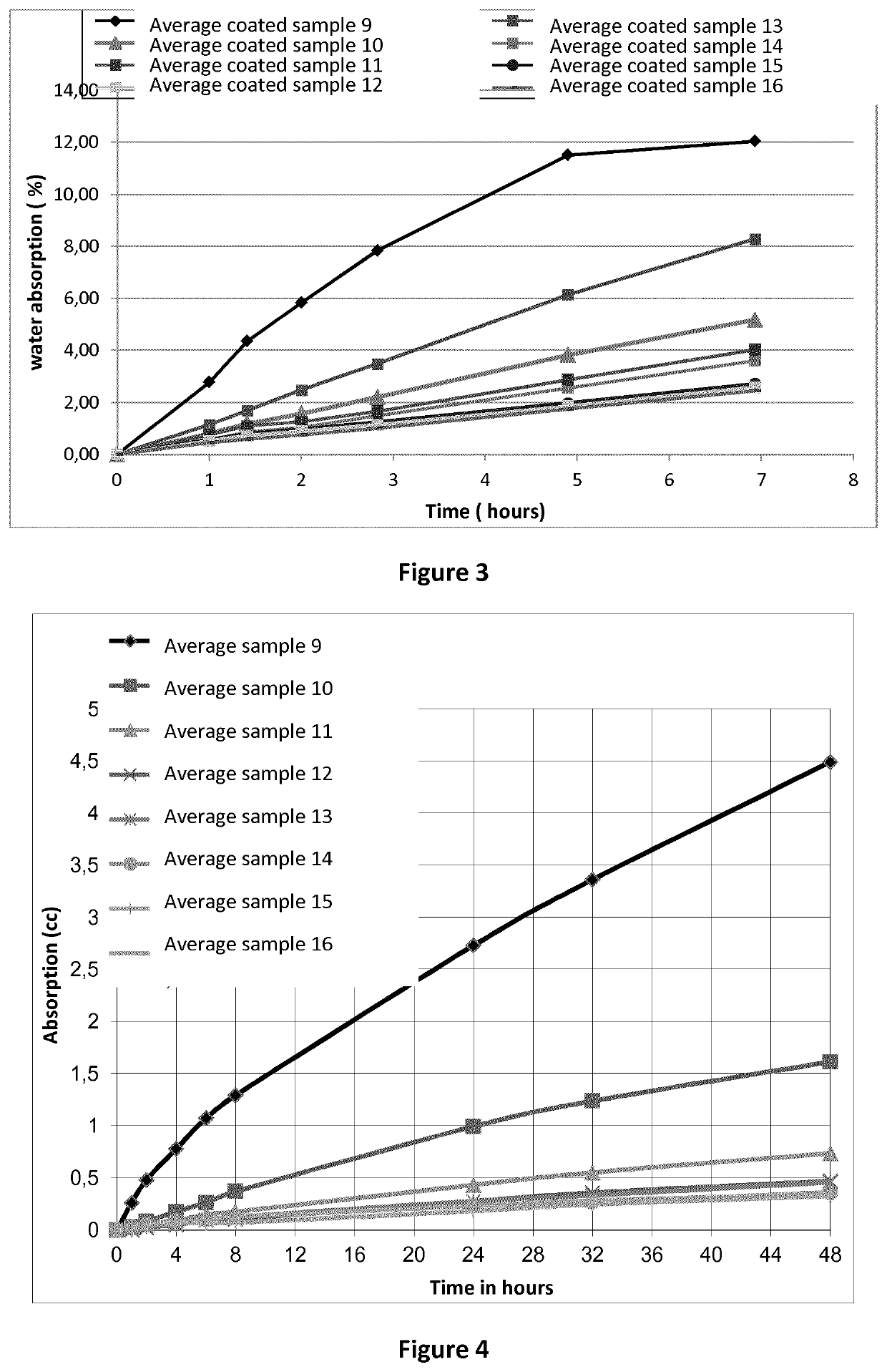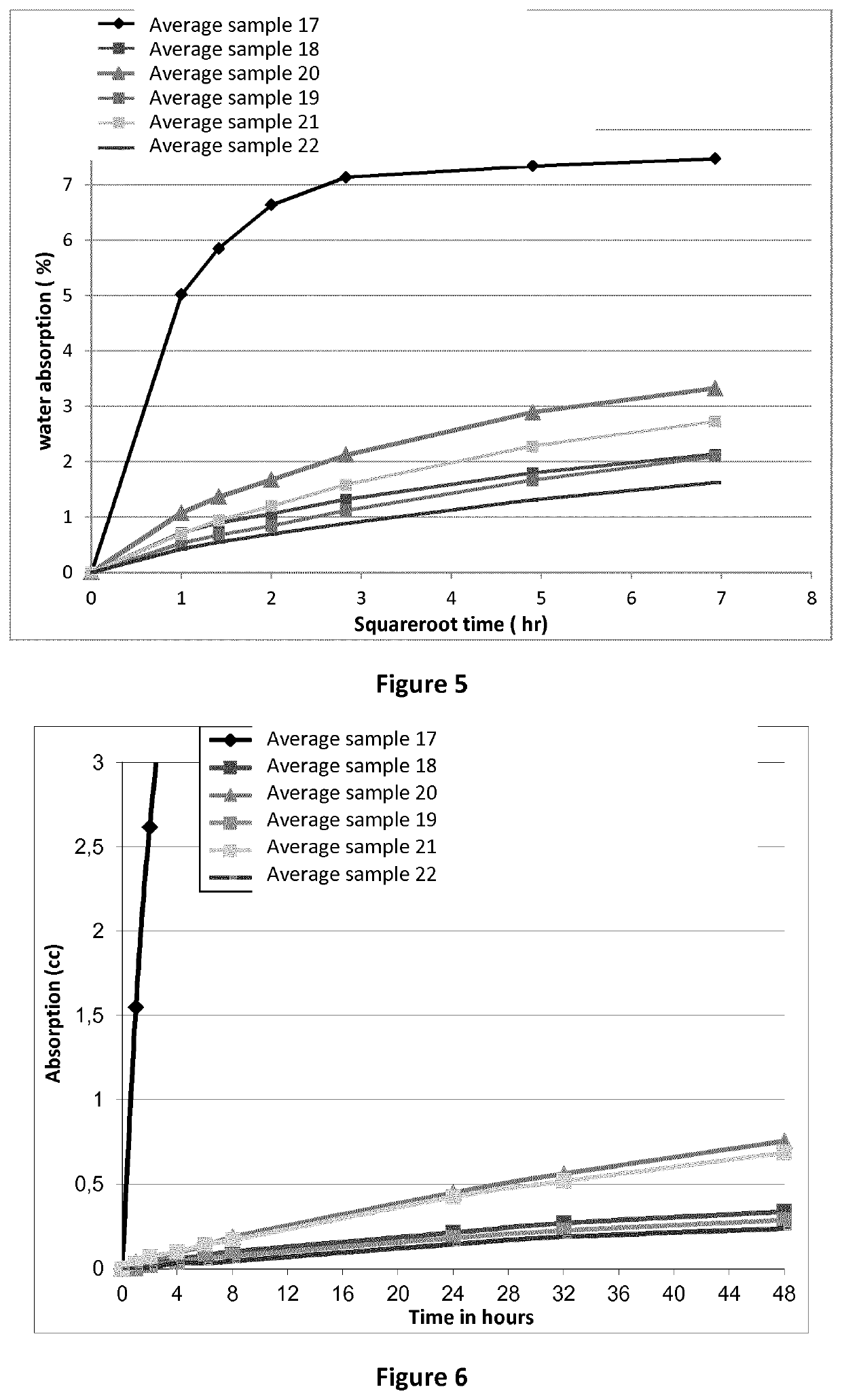Hydrophobized fiber cement products, methods for production, and uses thereof
a fiber cement and hydrophobic technology, applied in the field of fiber cement products, can solve the problems of insufficient water impermeability, most active hydrophobic agent migration into the process water, loss, etc., and achieve the effect of effective and efficient in-mass hydrophobicization of fiber cement products
- Summary
- Abstract
- Description
- Claims
- Application Information
AI Technical Summary
Benefits of technology
Problems solved by technology
Method used
Image
Examples
example 1
n of Air-Cured Hydrophobized Fiber Cement Products According to the Present Invention (First Series Air-Cured Samples)
[0204]A fiber cement slurry was prepared, comprising polypropylene fibers, cellulose fibers, fly ash, calcium carbonate, and cement, at a consistency of 20 to 23 weight percent of solids in water and was mixed for approximately 15 minutes. The cement slurry was diluted with water to 7 weight percent of solids. To the diluted slurry an anionic polymer flocculation aid and defoamer was added to generate fiber cement solids.
[0205]Different test slurry samples were prepared by admixing either (i) about 0.05% to 0.2% by weight of a hydrophobizing agent, which comprises a silicone resin (A) having a three-dimensional molecular network structure adsorbed to a synthetically prepared zeolite carrier (B) (see samples 2 to 4 in Table 1), or (ii) about 0.05% to 0.15% by weight of a silicone resin (A) (96% purity) having a three-dimensional molecular network structure (i.e. witho...
example 2
orption Tests for Air-Cured Hydrophobized Fiber Cement Samples Prepared in Accordance with Example 1
[0208]a) Capillary Water Absorption Test
[0209]The rate of absorption (sorptivity) of water by the fiber cement samples was determined by measuring the increase in the mass of a sample resulting from absorption of water as a function of time when only one surface of the specimen is exposed to water. Each sample was conditioned in an environment at a standard relative humidity to induce a consistent moisture condition in the capillary pore system. The exposed surface of the specimen is immersed in water and water ingress of unsaturated cement is dominated by capillary suction during initial contact with water.
[0210]The fiber cement samples 1 to 8, as produced in accordance with Example 1, were partially water immersed (in water bath) and the weights of the samples were measured after 1, 2, 4, 8, 24 and 48 hrs respectively. The capillary water absorption coefficient was determined at 24 ...
example 3
n of Air-Cured Hydrophobized Fiber Cement Products According to the Present Invention (Second Series Air-Cured Samples)
[0222]A fiber cement slurry was prepared, comprising polypropylene fibers, cellulose fibers, fly ash, calcium carbonate, and cement, at a consistency of 20 to 23 weight percent of solids in water and was mixed for approximately 15 minutes. The cement slurry was diluted with water to 7 weight percent of solids. To the diluted slurry an anionic polymer flocculation aid and defoamer was added to generate fiber cement solids.
[0223]Different test slurry samples were prepared by admixing either (i) about 0.05% to 0.2% by weight of a hydrophobizing agent, which comprises a silicone resin (A) adsorbed to a synthetically prepared zeolite carrier (B) (see samples 10 to 12 in Table 3), (ii) about 0.1% to 0.2% by weight of a hydrophobizing agent, which comprises a silicone resin (A) adsorbed to a colloid polymeric particle carrier (D) (see samples 13 to 15 in Table 3), or (iii)...
PUM
| Property | Measurement | Unit |
|---|---|---|
| viscosity | aaaaa | aaaaa |
| size | aaaaa | aaaaa |
| thickness | aaaaa | aaaaa |
Abstract
Description
Claims
Application Information
 Login to View More
Login to View More - R&D
- Intellectual Property
- Life Sciences
- Materials
- Tech Scout
- Unparalleled Data Quality
- Higher Quality Content
- 60% Fewer Hallucinations
Browse by: Latest US Patents, China's latest patents, Technical Efficacy Thesaurus, Application Domain, Technology Topic, Popular Technical Reports.
© 2025 PatSnap. All rights reserved.Legal|Privacy policy|Modern Slavery Act Transparency Statement|Sitemap|About US| Contact US: help@patsnap.com



